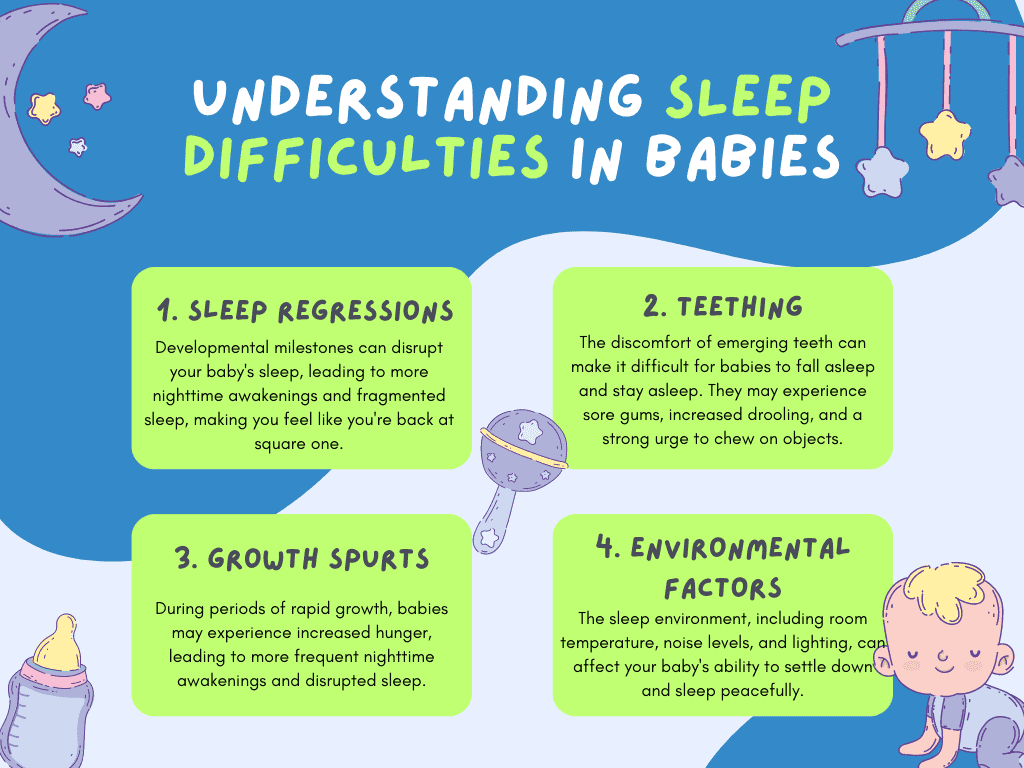
Unlocking Sweet Dreams: A Guide to Overcoming Baby Sleep Challenges
🍼 OBF24™ BLOG
Hey there, exhausted parents! We know how precious sleep is for both you and your baby, but sometimes those little ones just don't want to cooperate. Don't worry, though – we've got your back!
In this blog post, we'll dive into the world of sleep difficulties that babies often face and provide practical strategies to help your baby sleep peacefully. So grab a cup of coffee (or tea!) and let's explore how you can reclaim those precious Zzzs.
Understanding Sleep Difficulties in Babies
First, let's dive into understanding the various sleep difficulties that babies commonly face.

Now that you're aware of the factors contributing to your baby's sleep difficulties let's delve into effective strategies to overcome them.
Establishing a Consistent Bedtime Routine
When it comes to helping your baby sleep peacefully, a consistent bedtime routine can work wonders. By incorporating soothing activities, you create a predictable sequence of events that signals to your little one that it's time to wind down and prepare for sleep. Here are some key elements to consider when establishing a bedtime routine:
A Warm Bath
Start off the routine with a warm bath. Not only does it help relax your baby's muscles, but the change in body temperature afterward can also induce a feeling of drowsiness.
Gentle Massage
After the bath, consider giving your baby a gentle massage using baby-safe oils. This soothing touch can promote relaxation and further prepare them for sleep.
Lullabies and Soft Music
Fill the air with calming melodies by singing lullabies or playing soft, soothing music. The rhythmic sounds can have a calming effect on your baby's mind and create a peaceful atmosphere.
Bedtime Story
Engage your baby with a short and soothing bedtime story. The rhythmic tone of your voice, combined with the gentle storytelling, can help them unwind and transition into a sleepy state.
Cuddle Time
Before placing your baby in the crib, spend some quality cuddle time together. This physical connection and reassurance can provide a sense of security, making your little one feel loved and protected as they drift off to sleep.
Consider having sleep associations that contribute to your baby's sense of security and promote restful sleep, such as a favorite blanket, a soft toy, or a pacifier. As your baby grows, gradually transitioning away from these sleep associations can encourage independent sleep skills.
Managing Sleep Regressions and Developmental Milestones
While healthy sleep associations provide comfort, it's essential to address sleep regressions. These regressions can leave both babies and exhausted parents feeling tired and frustrated. Here's how you can effectively manage sleep regressions and provide support during these challenging periods:
Recognize the Signs
Sleep regressions often coincide with significant developmental leaps. These can include milestones like learning to roll over, crawling, walking, or experiencing separation anxiety. Keep an eye out for changes in your baby's behavior, such as increased fussiness, frequent night awakenings, or difficulty falling asleep.
Offer Extra Love and Comfort
During sleep regressions, your baby may need additional reassurance and comfort. Respond promptly to their cues, provide extra cuddles, and offer soothing techniques like gentle rocking or patting. Reassure your baby that you're there for them and help them feel secure during this period of adjustment.
Stick to the Routine
Even though sleep regressions may disrupt your baby's sleep patterns, it's important to maintain consistency with their established bedtime routine. Following a familiar routine can provide a sense of comfort and stability amidst the changes. Stick to regular nap times and bedtime.
Be Patient and Flexible
Remember that sleep regressions are temporary and typically last for a few weeks. It's essential to be patient and understanding during this time. Be prepared for some adjustments in your own sleep patterns and be flexible in adapting to your baby's changing needs. Trust that with time, your baby will gradually return to their previous sleep habits.
Seek Support if Needed
If you find that sleep regressions are significantly impacting your baby's well-being or causing excessive stress for you as a parent, don't hesitate to seek support. Consult with your pediatrician or reach out to a sleep specialist who can provide guidance tailored to your specific situation.
Addressing Teething and Growth Spurts
While maintaining a consistent sleep schedule is generally beneficial for your baby, there are times when temporary adjustments may be necessary to address specific needs such as teething discomfort or growth spurts.
During these periods, it's important to be flexible and make temporary adaptations to your baby's sleep schedule. Here's how you can navigate these adjustments:
Observe Your Baby's Cues
Pay attention to your baby's behavior and cues, as they may indicate changes in their sleep needs during teething or growth spurts. Increased fussiness, hunger, or difficulty falling asleep can be signs that their sleep schedule needs temporary adjustments.
Address Teething Discomfort
Provide relief by offering teething toys, chilled teething rings, or gentle gum massages. These soothing options can help alleviate their teething pain and improve their ability to fall asleep and stay asleep.
Adjust the Feeding Schedule
During growth spurts, your baby may experience increased hunger, which can impact their sleep. Adjust their feeding schedule to accommodate their increased nutritional needs. Ensuring they are well-fed and satisfied before bedtime can help them settle down and sleep more soundly.
Temporary Adaptations
Make temporary changes to the sleep schedule to address your baby's specific needs during teething or growth spurts. These adaptations may include slightly altering bedtime or naptime routines, as well as offering additional comfort and reassurance during nighttime awakenings.
Gradual Transition
Once the teething discomfort subsides or the growth spurt period passes, gradually transition your baby back to their regular sleep schedule. Reintroduce the established routine and gradually phase out any temporary adaptations made during the adjustment period.
Creating a Sleep-Friendly Environment
As we focus on ensuring your baby's comfort during sleep, let’s also consider the sleep environment. Here are tips for creating a sleep-friendly space that promotes relaxation and quality sleep.
Maintain a comfortable room temperature that is neither too hot nor too cold.
Minimize noise levels in the sleep environment to create a calm atmosphere conducive to sleep.
Use soft, dim lighting during nighttime routines and consider blackout curtains to create a dark sleep environment.
Dress your baby in comfortable sleepwear suitable for the room temperature to ensure they are cozy and not overheated.
Ensure the crib is a safe space with a firm mattress, fitted sheets, and no loose bedding or pillows.
Conclusion
So there you have it, parents! Remember, every baby is one-of-a-kind, and their sleep journey will come with its own set of challenges. But fear not! With the knowledge and strategies we've shared, you'll be equipped to navigate through those sleep difficulties and help your baby find a peaceful slumber.
Keep in mind to personalize these approaches according to your baby's unique needs. It may take some time and experimentation, but with plenty of love, patience, and a sprinkle of trial and error, you'll create a sleep routine that nurtures your baby's well-being and brings some much-needed rest to both of you.
Sweet dreams!

